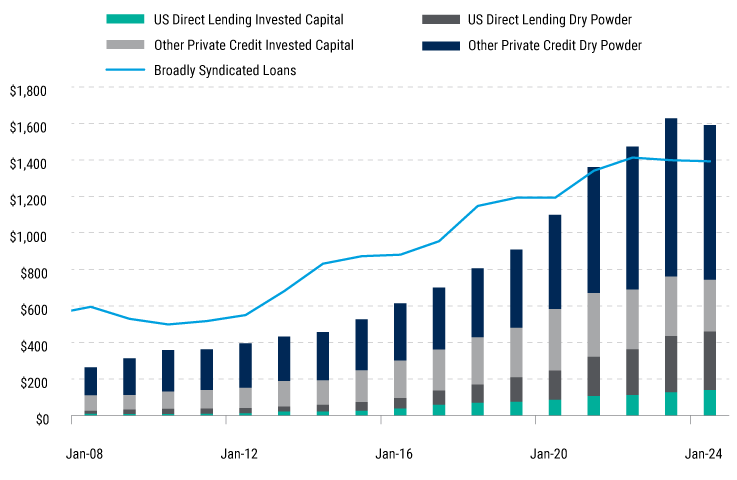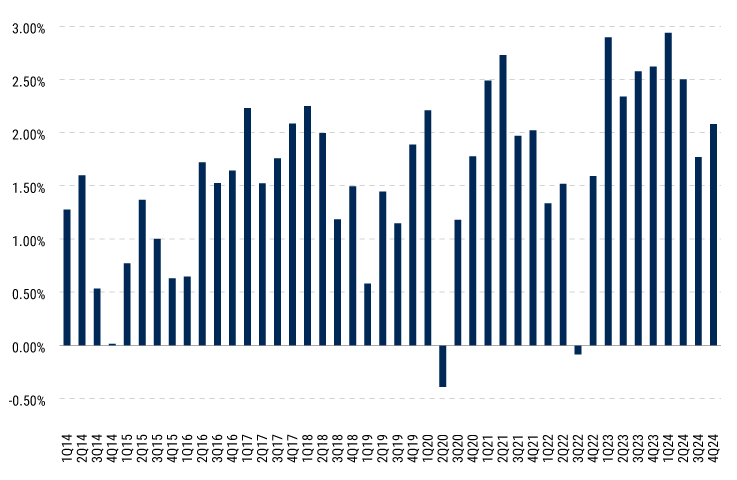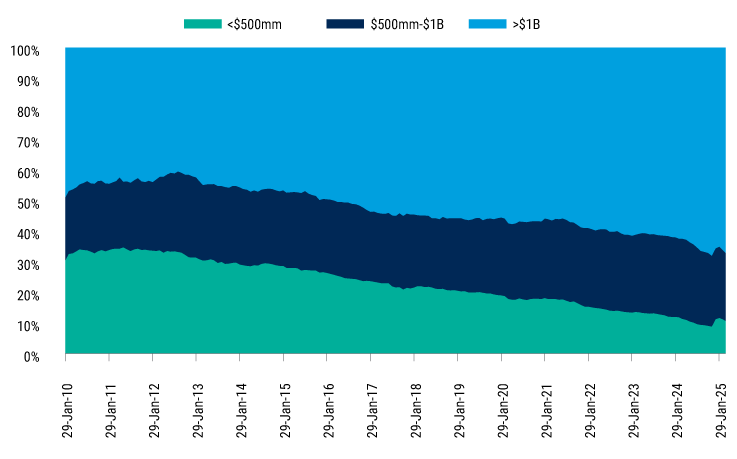Not Either/Or: Why Private Credit and Broadly Syndicated Loans Can Thrive Together

Kevin Wolfson
Portfolio Manager, US Leveraged Loans and CLO Management
The rapid expansion of private credit in recent years has not come with an offsetting decline in broadly syndicated loans (BSLs).1 We view aggregate growth in the credit markets as less about competition for the same assets and more about which market is best positioned to meet the moment.
While competition does exist between the upper middle market private credit and BSL markets, lower middle market companies seldom enter this ring, so this direct lending segment does not contribute meaningfully to competition between public and private credit.
The relative attractiveness of private versus public credit markets for investors will come down to the risk-adjusted return potential of each market, along with the investor’s diversification and liquidity needs, among other factors – and market conditions will continue to inform these determinations.
The dynamism between these markets offers greater diversification of financing sources for sponsors and borrowers and may lead to more stable credit markets.

The public and private credit markets are often perceived as rivals jockeying for the same limited pool of assets. Yet this is true only up to a point, and a closer look at these markets shows a more nuanced picture.
The competitive narrative specifically pits the upper middle market segment of private credit against broadly syndicated loans. While competition for these larger-tranche-size loans does exist, lower middle market companies seldom enter this ring; indeed, loans under $500 million make up just 11% of the BSL market today, down from 31% in 2010.2 Lower middle market direct lending thus does not contribute meaningfully to (or face pressure from) competition between public and private credit.
It’s also true that the private credit markets have ballooned in recent years amid a pullback in traditional bank lending and other dynamics, rising from roughly $806 billion in 20183 to roughly $1.6 trillion in 2023 and 20244 (see chart below). Yet, the broadly syndicated loan market has enjoyed a fairly steady climb as well, reaching a high of $1.4 trillion5 in September 2022 before dipping in 2023, followed by slight growth again in 2024.
As the chart below illustrates, growth in these markets is not a zero-sum game: the rapid expansion of private credit has not come with an offsetting decline in BSLs. Although the two markets at times find themselves in competition, in many ways they can be complementary, with room for both to thrive – and this dynamism offers greater diversification of financing sources for sponsors and borrowers and may lead to more stable credit markets.
Private Credit’s Ascent Has Generally Not Come at the Expense of BSLs
Growth in private credit and BSL markets (US$ billion)

Source: Preqin as of 1 April 2025 (Private Credit and Direct Lending) and Pitchbook as of 28 February 2025 (BSLs); “Other Private Credit Invested Capital and Dry Powder” includes Mezzanine, Special Situations, Distressed Debt, Fund of Funds, and Venture Debt.
We believe aggregate growth in the credit markets is less about competition for the same assets and more about which market is best positioned to meet the moment. For instance, in 2023, private credit markets stepped in as banks grew less willing to underwrite leveraged loans, providing financing for higher-risk transactions that otherwise might not have been completed at all (see chart). The public loan market contracted during that period, but the tide turned in early 2024, with a strong rally in leveraged loans during the first quarter flipping the script as demand outpaced supply. The following several quarters saw a more balanced picture between public and private credit takeouts.
The Give-and-Take Between BSLs and Private Credit Reflects Changing Market Conditions
Syndicated loans and direct lending takeouts (US$ bil.)

Source: Pitchbook as of 10 March 2025 (data through 7 February 2025).
We expect this dynamic to continue as market conditions change, and we see ways in which these markets could even be mutually supportive. Companies with BSLs facing tough refinancing conditions, for instance, could turn to the private markets for financing, potentially sidestepping defaults. Access to both markets is a clear benefit to issuers, allowing them to opt for whichever market offers more attractive features. Recently a handful of transactions have come to market that included both a public and private credit component. Although limited thus far, these transactions illustrate how the two markets may work directly together in certain situations to achieve a desired outcome.
Public and private credit have distinct benefits and risks for investors and sponsors
Investors are in part drawn to public credit markets because their money can be put to work quickly in liquid vehicles that offer broad diversification across industries and issuers. At the same time, sponsors who opt for the BSL market often enjoy lower debt costs and better terms with regard to ticking fees (fees imposed to compensate for lag time in a deal), which becomes important when transactions face increased regulatory scrutiny and delayed closings. BSLs also offer more flexibility for sponsors as to documentation and credit agreements.
Private credit, on the other hand, offers investors higher yields than BSLs given their illiquidity, with a roughly 167 basis point average yield premium over the past 10 years6 (see chart). They are also low-volatility (though not necessarily low-risk) investments given the lack of trading, and they have lower correlations with public markets. For sponsors, private markets offer greater certainty and quicker execution of deals since they are not subject to banks’ willingness to underwrite them or to the ability of banks to syndicate the debt when faced with the vagaries of CLO demand. Private deals also generally offer greater flexibility in underwriting and do not require credit ratings, and often allow for the use of payment-in-kind (PIK) or PIK/toggle loans, second liens, and holding company debt. Sponsors’ direct (and often long-term) relationships with companies allow them to step in if a borrower faces headwinds.
Private Credit Offers Higher Yields to Compensate for Illiquidity

Source: Refinitiv LPC 4Q24 Private Deal Analysis; yield premium represents the difference between upper middle market private credit loans and BSLs.
One concern for investors, of course, is that in courting issuers, borrowers in both markets may sweeten terms in ways that allow standards to slip. Indeed, certain public deals have begun to offer some of the same inducements common to private transactions, such as delayed-draw term loans. The potential for mispricing of risk and erosion of investor protections are legitimate concerns which, in our view, call for an active approach to investing that assesses each transaction and borrower’s specific risks.
Peaceful coexistence is possible
The recent growth of private credit is not the end for public loans, and we believe the two markets will instead complement one another in general while potentially competing at the margin. We view the upper middle market portion of private credit as more vulnerable to the latter, with transactions of $350 million and up more likely to see some competition, while smaller lower middle market deals should be largely immune.
Smaller Loans Make Up a Shrinking Portion of the BSL Market
S&P UBS Leveraged Loan Index by Facility Size

Source: S&P UBS Leveraged Loan Workbench 26 March 2025.
We believe private credit steps in when either 1) public loan markets become closed to sponsors with respect to certain transaction types, including second liens, “storied” (sub-investment-grade) credits, and the like; or 2) sponsors are seeking certain structural options (e.g., PIK loans), flexible underwriting, or other benefits discussed here. The upshot is that where some contraction in the size of the public loan market may occur during certain periods, this will ebb and flow over time in step with changing conditions.
It comes down to what matters most to sponsors and the level of demand within each market at a given point in time. We believe this dynamic could potentially have more negative implications for upper middle market private credit than the BSL market, given that public credit already pays lower spreads and is less onerous for borrowers, requiring only light documentation and no covenants. We don’t expect private credit to reach true parity with public loans on the cost of debt or documentation, given that some illiquidity premium must be in place to attract borrowers to this space.
The relative attractiveness of private versus public credit markets for investors will come down to the risk-adjusted return potential of each market along with the investor’s diversification and liquidity needs, among other factors – and market conditions will continue to inform these determinations.
We believe successful investing in both broadly syndicated loans and private credit requires an active approach founded on in-depth issuer research, robust risk assessment, and a strong understanding of the opportunities and challenges of each market. The question for investors is how to allocate between public and private credit markets to tap the benefits of each amid an economy and markets in flux. A flexible approach can help investors reap the benefits of both public and private credit by determining how best to deploy capital given current and expected conditions.
1 Source: Preqin as of 1 April 2025 (Private Credit and Direct Lending) and Pitchbook as of 28 February 2025 (BSLs); “Other Private Credit” consists of Global Mezzanine, Special Situations, Distressed Debt, Fund of funds and Venture Debt.
2 Source: S&P UBS Leveraged Loan Workbench, 26 March 2025
3 Source: Preqin as of 1 April 2025.
4 Source: Preqin as of 1 April 2025.
5 Source: Pitchbook as of 28 February 2025.
6 Source: Refinitiv LPC 4Q24 Private Deal Analysis.
Disclosure
Investing involves risk, including possible loss of principal. The information presented herein is for illustrative purposes only and should not be considered reflective of any particular security, strategy, or investment product. It represents a general assessment of the markets at a specific time and is not a guarantee of future performance results or market movement. This material does not constitute investment, financial, legal, tax, or other advice; investment research or a product of any research department; an offer to sell, or the solicitation of an offer to purchase any security or interest in a fund; or a recommendation for any investment product or strategy. PineBridge Investments is not soliciting or recommending any action based on information in this document. Any opinions, projections, or forward-looking statements expressed herein are solely those of the author, may differ from the views or opinions expressed by other areas of PineBridge Investments, and are only for general informational purposes as of the date indicated. Views may be based on third-party data that has not been independently verified. PineBridge Investments does not approve of or endorse any republication of this material. You are solely responsible for deciding whether any investment product or strategy is appropriate for you based upon your investment goals, financial situation and tolerance for risk.



